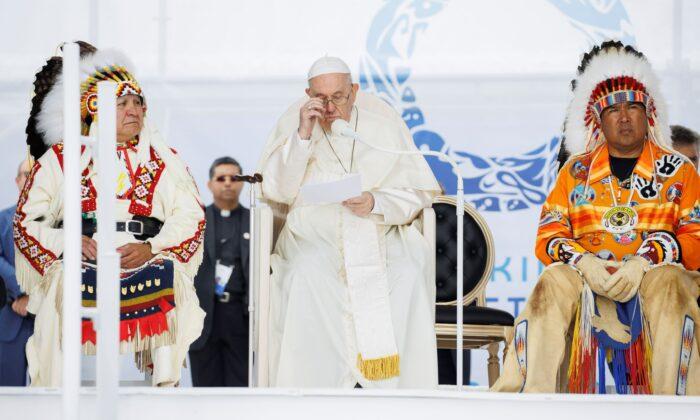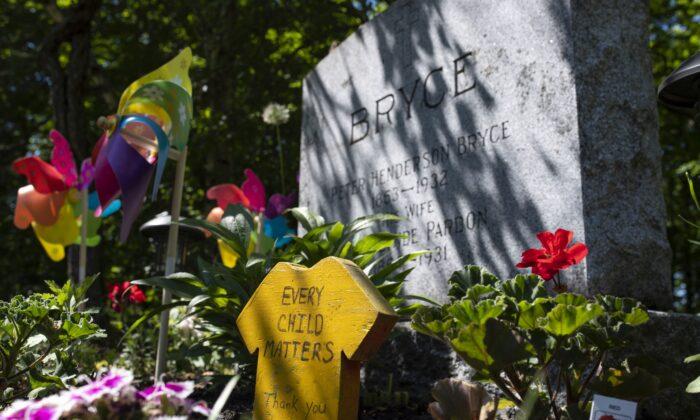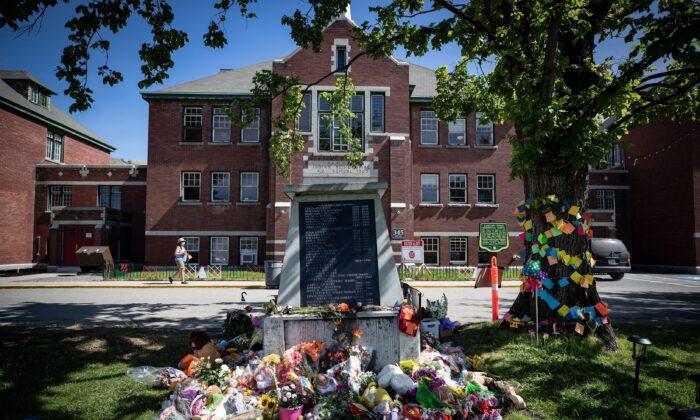Commentary
“I know of the gratitude that you yourselves, the Indian and Inuit peoples, have towards the missionaries who have lived and died among you. What they have done for you is spoken of by the whole Church; it is known by the entire world. These missionaries endeavoured to live your life, to be like you in order to serve you and to bring you the saving Gospel of Jesus Christ.
“Whatever faults and imperfections they had, whatever mistakes were made, together with whatever harm involuntarily resulted, they are now at pains to repair. But next to this entry, filed in the memory of your history, is the record, with endless proofs, of their fraternal love.
“That marvellous rebirth of your culture and traditions which you are experiencing today owes much to the pioneering and continuing efforts of missionaries in linguistics, ethnography and anthropology. ... Yes, dear Indians and Inuit, the missionaries have always shared in your cultural and social life.”
These glad tidings were spoken by a Catholic pope. No, not Francis, the current one, a
liberation theologian for whom a
New Age social gospel trumps the age-old personal salvation one. Instead, they were uttered by Pope John Paul II—a traditionalist and
stern critic of Marxist-based liberation theology—at the Yellowknife Airport in the Northwest Territories of Canada in 1984.
Thirty-eight years later, Pope Francis delivered a far darker and less nuanced message in his “
penitential pilgrimage” of confession and apology for the mostly unproven sins committed by members of his church against indigenous children in Canada’s Indian Residential Schools (IRS).
In his
July 25 address on the grounds of the old Ermineskin Indian Residential School at Maskwacis in central Alberta, Pope Francis said:
“I have come to your native lands to tell you in person of my sorrow…
“I recall the meetings we had in Rome four months ago. At that time, I was given two pairs of moccasins [representing the bodies of missing children] as a sign of the suffering endured by Indigenous children, particularly those who, unfortunately, never came back from the residential schools. … “It is necessary to remember how the policies of assimilation and enfranchisement, which also included the residential school system, were devastating for the people of these lands. … Again, I think back on the stories you told: how the policies of assimilation ended up systematically marginalizing the Indigenous peoples; how also through the system of residential schools your languages and cultures were denigrated and suppressed; how children suffered physical, verbal, psychological and spiritual abuse; how they were taken away from their homes at a young age, and how that indelibly affected relationships between parents and children, grandparents and grandchildren.
“In the face of this deplorable evil [cultural destruction and forced assimilation], the Church kneels before God and implores his forgiveness for the sins of her children.”
In his apology, the Pope actually repudiated the missionary role of the Catholic Church—indeed indirectly all Christian churches—a role given to what became the Christian church by the teachings of Christ in the gospels. Also, there is no evidence whatsoever that the indigenous people of Canada were in any way forced or even browbeaten to accept Christianity, and plenty that they willingly accepted conversion. (Of course we know that forced conversion to Catholicism actually took place elsewhere in the world.)
How can these two incompatible versions of the Catholic Church’s identical interaction with indigenous people be reconciled?
In addressing this question, the key is explaining why Maskwacis, of all places in Canada, was chosen for this papal apology.
A straightforward but incomplete answer is that Maskwacis is not Kamloops, even though the Holy Father would never have made a pilgrimage to Canada save for the announcement on May 27, 2021, of “
the confirmation of the remains of 215 children who were students of the Kamloops Indian Residential School,” in graves
also said to contain students murdered by the school’s Catholic priests. Over 14 months later, this outlandish confirmation still has not an iota of truth attached to it.
So why would this pope avoid what brought him to Canada—especially when
so many indigenous people urged him to come—if this were a “penitential pilgrimage,” as he claimed, and when apologies have been issued abroad by other popes on other occasions, including by John Paul II when he
visited the Auschwitz concentration camp in Poland in 1979.
The answer lies well outside the Kamloops heart of darkness in the soul of benevolence,
Maskwacis itself, home to the former Roman Catholic-operated Ermineskin Indian Residential School.
The first clue revealing its choice is that no ground-penetrating radar (GPR) study looking for possible unmarked graves had taken place around the old school grounds, or that any such search produced even minimally incriminating evidence of possible human remains in the form of disturbed soil, which is about all GPR can reveal.
Another clue is that despite housing thousands of students over the years, only 15 deaths are recorded at the Ermineskin school on the National Centre for Truth and Reconciliation’s (NCTR)
Memorial Register for its 79-year history. Though the Memorial Register reports these children as having died while attending the school, the four whose
records were found by a researcher who prefers to remain anonymous, suggest they were properly buried on their home reserves.
Confirmation of the date of death of six children is not listed, suggesting that the NCTR neglected to search the meticulously kept school records maintained by their teachers, mainly nuns, to determine their fate.
The best clue of all explaining the Pope’s apology at this site is the content of everyday life in the Ermineskin Residential School and those like it in rural Alberta. There is a large body evidence revealing that these schools were far from the
horror houses depicted in the media and the
2015 Truth and Reconciliation reports, the latter based on the decades-old unverified verbal recollections of former students.
Detailed chronicles written in diary-like fashion by
three religious orders of nuns minutely describe the love and dedication of women who sacrificed their entire adult lives nursing, teaching, and mothering indigenous children, many of them orphans and abused children, for decades at the Erminskine school. Three books of these chronicles, never intended for public release, thereby enhancing their credibility, can be found
here.
Anyone reading the chronicles of the Sisters of the Assumption of the Blessed Virgin (1894–1936) could not help but be impressed by the concern and care they showed for indigenous children. Always referred to as “
our dear children,” the youngsters were neither neglected nor punished for wrongdoing beyond the standards of the time.
Apart from classroom teaching and practical education, Ermineskin was the site of many outings, picnics, feasts, and concerts. Except for orphans and neglected or abused children, its students went home for day-holidays and long summer vacations. Conversely, parents visited their children whenever they wished. If families needed their older children at home for help with farming or other activities, this was always permitted.
In sum, the site of the Ermineskin Residential School was the ideal locale for Pope Francis to offer an apology, one which also allowed him to fleetingly state that there were, “many outstanding instances of devotion and care for children [in the residential schools].” An understatement if there ever was one, it still repudiates the inflammatory and groundless charge by Fred Hiltz, the former archbishop and primate of the Anglican Church of Canada, that there was “
nothing good” about the residential school system.
But there may be a glimmer of hope in this whole poorly investigated matter, because the Pontiff seemed to equivocate toward the end of his address by stating that:
“[L]ooking ahead to the future, no effort must be spared to create a culture able to prevent such situations [as occurred at the IRS] from happening. … An important part of this process will be to conduct a serious search into the facts of what took place in the past and to assist the survivors of the residential schools to experience healing from the traumas they suffered [emphasis added].”
Decoding these words is tricky, but if they suggest some doubt that the Truth and Reconciliation Commission’s
final report is the last word about the Indian Residential Schools, as its many supporters contend, there is still hope that the true face of Canada’s residential schools will someday be revealed.
Views expressed in this article are opinions of the author and do not necessarily reflect the views of The Epoch Times.





